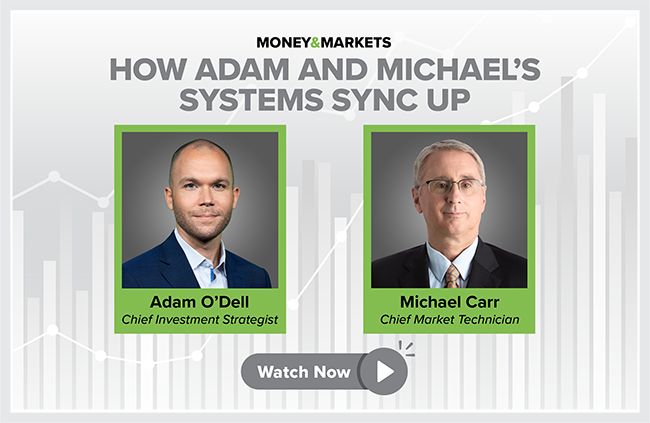When I found out we were bringing Mike Carr into the Money & Markets fold, I had one response: “Why did it take this long?!”
Jokes aside, it felt like such a natural move…
Like Adam O’Dell, Mike is laser-focused on developing trading systems that work. And they both strive to help anyone understand how to maximize the potential these trading systems hold.
And that’s what Mike did with his brand-new Apex Alert. He’s developed a seasonal strategy that implements Adam’s Green Zone Power Ratings to find the best stocks to buy during 15 specific profit seasons each year. If that already sounds intriguing enough, click here to watch his brand-new Apex Profit Calendar summit now.
But if you’re still curious about Mike and how he’s incorporating Adam’s systems into his own, we’ve got you covered.
Below you’ll find a snippet of a recent conversation between Mike and Adam. They go over the broader strokes of Apex Alert, and why Green Zone Power Ratings was the perfect fit for this brand-new strategy.
Click here or the image below to start watching now.
Here are some time stamps to jump to a specific topic:
- Apex’s holding period and sector rotation. [0:00]
- How Mike is maximizing Green Zone Power Ratings. [2:32]
- The long view with Apex Alert. [5:59]
- Benefits of a concentrated portfolio. [8:00]
If you prefer to read, you can check out a transcript of Mike and Adam’s conversation below.
The Right Rotation
Adam: So tell us a little bit about sector rotation and the time frame on which you’re using seasonality and some of the reasons why, for example, in the energy sector or oil and gas or whatever sector you’d like to talk about, you start to see some of these seasonal patterns.
Mike: I mean, you’ve had great success with that short-term strategy, and your readers, your subscribers have enjoyed that so much.
This [new strategy] is longer term. We’re looking at maybe an average of 45 days, some shorter, some longer, and we’re just looking at the seasonal patterns in the sectors and they occur because the same things happen at the same time.
Every year, companies release earnings at about the same time. So we have those four events marked out on the calendar. Stocks react to that.
Drilling down a little bit deeper, trade shows occur at the same time every year. You know, the Consumer Electronics Show in Vegas is the same time every year. That’s a well-known one. But the biotech companies all get together at the same time every year and they want to make a big splash there. They introduce their new products. We see the same in every sector.
So there’s an underlying reason that a sector will move at a different time and maybe we can understand it. You know, going back to, like you said, the best six months, the reasoning behind that is the fall has historically been a tough time for stocks, and that goes back to the 1800s.
And it was easy to understand that money was gold. They used to put gold on the train and send it out west in the fall so that banks would have money to give to the granaries to buy the corn from the farmers. And then the farmers would repay the loans to the banks. The money would go right back on a train. Markets crashed because they didn’t have enough money.
Why does it work today that way? Why are September and October so dangerous? No explanation at all, just tradition. But it had a great reason in the 1800s.
So we’re seeing that play out. We’re just jumping on the right sectors now. We’re finding when they’re up and down through backtesting. And then we have looked for the reason we understand the rationale behind it, and then we find the stock books.
Adam: This is why I love talking with Mike Carr and trading emails with him. His knowledge of financial history is like none other, and it is so interesting. We’re a lot more than data-driven geeks.
But yeah, your stories are always spot on.
Apex and Green Zone Power Ratings
I always think about oil and gas prices. You know, even your anchor on your nightly news knows that gas prices tend to be higher in the summer because more folks are driving and there’s more demand and there’s certain production and shutdown schedules where they do maintenance and CapEx.
So a lot of these things have a real reason, and you don’t necessarily know about them by reading The Wall Street Journal or watching your evening news. But, you know, geeks like us figure out what these seasonal patterns are nonetheless.
So if I understand you correctly, you have a whole calendar and you know which sectors tend to be bullish or bearish or at least weak, maybe underperforming during certain parts of the year. I got that. Your holding period, the time that you’re trying to be in trades is roughly 45 days. So about a month and a half, right, on average.
And then once you determine that a particular sector is entering a very seasonally favored period of time, then you will drill down into that sector and try to find one or more stocks that look best positioned to take advantage of that seasonality.
Mike: That’s the easy part. Once we find the right sector, we just pull the ratings for that sector and we sort from high to low and pop. That’s not too complex a process and we take the one on top and that’s it. It’s that easy.
Adam: Okay, So by one on top, you’re talking about using the Green Zone rating.
Mike: Green Zone power ratings, highest rated in that sector.
Adam: So from what I know about the system, if it’s highest rated, it means that it’s probably cheap. It’s probably very, very cheaply priced or at least fairly priced.
It’s probably a quality business that doesn’t have too much debt and has good cash flows, has growing earnings and revenues. Its price action is in an uptrend or has strong momentum and lower volatility than it probably would if it was in a different sector or relative to its peers.
And does it tend to skew more towards smaller companies? We know that there’s some debate over this of where it’s most effective. But generally speaking, small-cap companies tend to outperform large- and mega-cap companies. It hasn’t been this way these days … but you’re looking for generally smaller underappreciated companies, or will you go anywhere on the size spectrum?
Speaker 2: We’re going wherever the ratings tell us to go.
So I do think we’ll see more of the small caps in testing. We saw a mix of small and large cap, so we don’t know going into any given calendar period what it’s going to be. And that’s I think the beauty of your system is each of those factors is going to have to have a strong rating in order to give it the overall highest rating.
You know, we’re not going to see a stock with zero momentum at the top of the list because it’s just designed to avoid that problem. So I think that’s the value that we’re adding there.
Adam: Yeah, I like to describe it as we’re looking for well-rounded stocks.
You know, frankly, it has probably been a few years since I’ve been in the gym and I don’t know about you Mike, but you always look at those guys that maybe they have huge biceps, but their legs are like this, like mine. And you know, they’re weak in that sense.
And we’re not looking for stocks that are really good values, but horrible quality businesses. We’re not looking for stocks that have rocketing stock prices but are bleeding cash. We’re looking for well-rounded stocks that kind of meet those criteria altogether. And those are the ones that just statistically have the best chance of outperforming.
Take the Long View With Apex Alert
Adam: So what’s the general experience like with this portfolio? Are you looking to hold roughly how many positions, how quickly will you be trading in and out of them? Will you always be long? Will you have some short trades?
Mike: We’re always going to be long. We’re going to be in that primary sector.
So there’s 15 times a year where we’ll have the calendar trade and we’re also going to exploit seasonality. So we’re going to look at certain times during the month that have strong seasonal tendencies, and these exist not just in the U.S. stock market but around the world.
So we can trade a lot of U.S.-listed companies with headquarters in Korea that reflect more the Korean market trends than the U.S. trends. So we’re going to get our diversification that way and will buy in on the calendar date. We’ll close out on the calendar date. You’ll have all this in advance so you’ll know when we’re getting in, and when we’re getting out. We’ll just look at the company at the time that is the right stock.
So it’s really very simple, very straightforward. Typically, we think we’ll have three to five positions at a time, but that’s going to vary based upon the particular seasonal trends — and that month. If we have a bullish month, we may have more. So we’re going to make sure that we’re always in the right stock at the right time.
Adam: That’s great. And that answer is music to my ears. Three to five positions at one time, and it will vary.
Folks, you can’t set anything like this so precisely. There just are fewer opportunities and you don’t want to swing at bad pitches and then miss other market opportunities. They’re just these fat pitches coming down the plate, one after the other after the other, and you have to take advantage or make hay while the sun shines.
But what I really like about a reasonable number of positions is twofold. And I think that you’ll probably agree because we’ve talked about this before.
Why a Smaller, Concentrated Portfolio Works
Adam: But one, it allows all of our readers and the folks who are following us at home to actually copy our portfolios. I’ve seen some, you know, newsletter analysts that have portfolios of 50 or 70 or 80 or 90 stocks. And the problem with that is that if you have a certain account size and you’re trying to spread your capital across all of those, it can become very cumbersome and not everybody can follow that. And then we get into this issue where folks pick and choose which stocks they want and that introduces this whole variable of luck rather than the edge in our system.
The other reason I like this idea of a smaller portfolio is that I like to say that if you’re already ultra-wealthy, being extremely diversified is the best way to go because there’s no way that you can lose that wealth. Right? But if you’re not already there and you’re trying to play catch up on your retirement goals or you’re trying to get ahead, or you want to beat the market, you want to get some juiced returns, you can’t be overly diversified. There’s no way that you can be as diversified as the S&P 500 and expect to beat the S&P 500 by three or five or 10 to 1.
So you have to run what’s called a concentrated portfolio. And while that concentrated portfolio might move around a bit more, and have more volatility at the portfolio level than the S&P, as long as it has a positive edge, a positive expectancy over the long run, that’s really how you can get those market-beating gains.
So I’m excited about Apex and if there’s anything more you want to share about it, the floor is yours.
Mike: But no, we’re excited about this. It’s based on a lot of just research into the calendar.
And you know, you mentioned that 80 or 90 stock portfolio and I see a lot of that. So if you allocate equally to all of them. None of them are going to make you a lot of money. You know, you have a 1% position. The stock goes up 300%. You made nothing. Right. But you can brag about that 300% gainer and make it sound like it was a huge hit. Right. But it meant nothing to your wealth.
So the concentrated portfolio, I’ve always thought, is the way to go. And that’s why we’re going to just bring that idea to here. We’re going to drill down. You know that some times of the year around the holiday, you make out a trade. And we have seen some great trades around holidays and the end of the month just because we don’t know why really, people are happier around holidays. Maybe that’s it around the end of the month.
We do know that there’s a lot of cash going into retirement accounts. We also know that large fund managers have to invest cash. The managers look at the end of the month and it’s a big thing when you manage money like you did. We get paid to manage stocks, not cash.
Adam: Right.
Mike: So if you have a 20% cash position, your boss is going to come down on you or your clients are going to say: “What am I paying you for?” So people just buy.
Adam: Mm-hmm.
Mike: And that drives the market up in those last months. And most funds, are very low 1 to 3% cash that you can hold. So if you’re if you see a lot of bearishness in the news, you know, at the end of the month, there’s a good chance there’s a lot of cash that has to go into that market.
Adam: And also makes me think of the phenomenon that’s called window dressing. I mean, this sounds ludicrous, but this idea that you know, funds put out quarterly reports of what their holdings are, and what they don’t want to do is be the fund that missed out on the stock that had been doing really, really well over the previous quarter.
So often what they’ll do is they’ll look at which stocks have been doing really, really well. And then in the last couple of days of their reporting quarter, they’ll buy that stock so that when they send out the report to their investors, they can say: “Yes, we were in this stock as well.” You know, whether it’s Nvidia or Apple or whatever other big-name one, but obviously didn’t impact the returns. So it’s kind of a smoke and mirrors thing and that’s why it’s just ludicrous.
But that’s one of the reasons why we see price momentum in stocks that have been doing well up until the quarter’s end. They will continue to do well because these fund managers that were behind the curve will kind of pile into them and that will cause the price action to continue.
So just some fascinating stuff with seasonality.
Back to the topic. I mean, we still have investors making their own decisions and hedge fund managers making their own decisions. And human nature doesn’t change all that much. And so if you can find things that work in the market that are based on human behavior, that doesn’t change even though the markets are changing. I think that’s really where we find our gold.
Mike: It is.
And like you said… window dressing, it does sound ludicrous. It actually happens. I was so shocked to learn that that was real. I always thought nobody would do that. And then when I managed money, I had a mutual fund and we would get the reports and we could see actual window dressing. At the end of the month, the fund trustee would send out reports showing the buys and sells and you would just see it.
I don’t understand who would believe that they’re doing that because you’re reporting you own this stock and here’s your price. You can look and see. You didn’t make any money on it. Sure. But it’s right there. The investors didn’t do that. So all the information was there for them. It’s still done. I don’t know why, but it is.
Adam: Well, we know about it. We can take advantage of it. And so be it.
Mike: Exactly. It will always be done, too.
Adam: Yeah, absolutely.
Like Adam said, Mike’s market knowledge is like no other, and I can’t wait to see what both Adam and Mike have for you all next.
And if you want to learn more about Mike’s new Apex Profit Calendar, click here. Take a moment to see the massive potential of this easy-to-follow approach.
Have a great rest of your week!
Until next time,

Chad Stone
Managing Editor, Money & Markets





